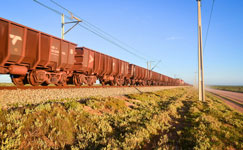South Africa pours cash into infrastructure
18 June 2015
By the end of 2014, South Africa had spent R1-trillion on developing its
infrastructure.
"The expenditure was in areas such as energy, water infrastructure, sanitation, rail,
road-based public transport, and hospital revitalisation, among others," said
Minister in the Presidency Jeff Radebe.
Speaking on Wednesday during the Vision 2030 Summit, Radebe highlighted the
work that was under way as part of implementing the National Development Plan
(NDP) specifically in infrastructure development.
The NDP is aimed at eliminating poverty and inequality by 2030.
He said investments in infrastructure would expand South Africa's economic
opportunities.
Investments in the energy sector, he told delegates, included the construction of
Medupi and Kusile power stations and Ingula Pumped Storage Scheme.
"South Africa has enabled significant investment in the renewable energy sector
totalling some R168-billion in
the four bidding windows announced to date," he said,
referring to the Renewable Energy Independent Power Producer Procurement
Programme.
South Africa was regarded as a global leader in renewable energy, having approved
79 independent power producer projects totalling 5 243 megawatts.
Last year, Transnet announced a R50-billion investment to manufacture more than 1
000 locomotives.
"The plan is that all locomotives except for the first 70 will be manufactured in
South Africa and delivered by 2019… This will significantly expand Transnet's
general freight capacity to support economic activity as well as expand the
country's industrial capacity."
In 2012, Transnet Freight Rail announced the expansion of the Sishen iron ore line
for R28.6-billion. The project was under way.
In addition, R7-billion had been earmarked for investment in the country's ports by
Transnet Ports Authority as part of Operation Phakisa, which is aimed at
unlocking
the economic potential of the its oceans.
"A further commitment of R9.2-billion of public and private investment for the
construction of a new berth in Saldana Bay, the extension of the Mossgas Quay and
the refurbishment of the Offshore Supply Base has also been made," Radebe said.
The Passenger Rail Agency of South Africa (Prasa) had awarded a tender for new
rail rolling stock estimated to cost R51-billion. Prasa would spend R4-billion on new
hybrid locomotives over 10 years.
"A rail passenger factory will be established in Nigel, Ekurhuleni for the
manufacture and assembly of locomotives and trains. It is expected that over 65
000 direct and indirect jobs will be created."
An upgrade of the Moloto Road was also recently announced, costing R1.1-billion, to
improve safety and mobility on this road. The notoriously dangerous road, the
R573, links Tshwane with Mpumalanga and Limpopo.
In other expenditure, South Africa would spend
R13-billion on the Research,
Development and Support Programme through the Department of Science and
Technology.
The department would also make transfers to the National Research Foundation of
R2.7-billion to support 4 539 researchers, 15 918 Masters students and 9 615
doctoral students.
"It is important that we understand that initiatives by [the] government are not
undertaken in isolation and form part of a broader mandate to expand economic
opportunities and improve the lives of our people," Radebe said.
Source: SAnews.gov
 The iron ore train on the Sishen-Saldanha railway, near Lamberts Bay on the West Coast. (Image: JBdodane, Flickr)
The iron ore train on the Sishen-Saldanha railway, near Lamberts Bay on the West Coast. (Image: JBdodane, Flickr)
 The iron ore train on the Sishen-Saldanha railway, near Lamberts Bay on the West Coast. (Image: JBdodane, Flickr)
The iron ore train on the Sishen-Saldanha railway, near Lamberts Bay on the West Coast. (Image: JBdodane, Flickr)